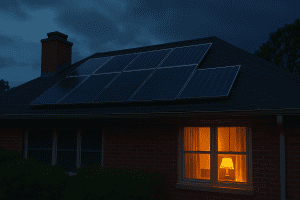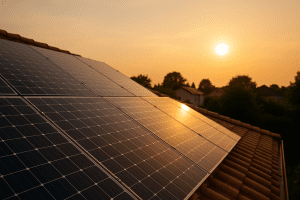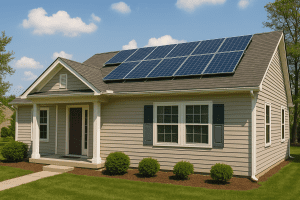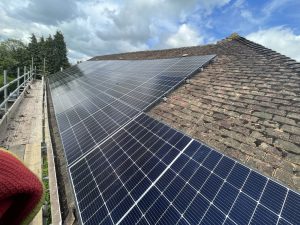The Ultimate Guide to Bird Proofing Solar Panels in the UK 2025
Written By
- Alex Rohn
Published on
- 08 Apr 2025
Solar panels are a cost-effective and environmentally friendly investment. But many homeowners and commercial property owners, however, are finding a hidden enemy: birds nesting under or around solar arrays. Although the panels themselves are robust and built for years of exposure to the elements, they were never meant to resist a determined pigeon or a flock of starlings. Bird-related problems have increased proportionally in the UK, where solar panel installations are rising, particularly on rooftops. What seems like an innocent presence—birds seeking warmth and shelter—can lead to performance degradation, long-term physical damage, and higher maintenance costs. In this guide, we investigate why bird proofing is important, what causes the problem, the most effective solutions, and how to implement them safely and legally.
What Draws Birds to Solar Panels?
The Shelter Effect
The area between the roof and the solar panel offers a safe, cave-like setting. Birds, especially pigeons, are attracted to these areas as they:
- Offer protection from wind and rain — a dry and secure nesting site makes panels an ideal hideaway.
- Are warm due to panel heat — panels maintain heat that birds use for warmth, especially during winter.
- Provide hiding from predators like cats and hawks — the under-panel area gives birds peace from common urban threats.
- Remain quite undisturbed by human activity — solar arrays are rarely examined or maintained daily, creating a low-interference zone.
The Urban Bird Boom
Urban areas see higher incidences of bird attack under solar panels due to:
- Higher pigeon numbers—pigeons flourish in cities and are the most frequent rooftop nesters.
- Fewer trees or natural places for nesting — solar panels often replace natural habitats birds would have otherwise used.
- Human-provided food sources—bins, food litter—easily accessible food attracts birds to houses and businesses.
- Large uninterrupted roof spaces with panels — bigger setups offer more shelter and nesting opportunities.
Year-round Nesting
- Pigeons breed year-round. They can nest several times a year in the UK, which puts your solar panels at risk in almost every season.
The Unspoken Dangers of Birds Nesting Under Panels
- Lowered Efficiency
Bird droppings can coat the surface of solar panels and block light because of their acidity. A tiny bit of shadow can significantly reduce output. A string inverter system’s one shaded panel can reduce the total output of the array, hence greatly lowering its efficiency and energy production. - Dry twig, leaf, and feather nests are very combustible
When close to wire and electrical components, these nests increase the likelihood of electrical fires from overheating or short circuits. - Wiring Damage
Birds often shift or chew on wires when building their nests. Damaged wiring could cause short circuits, erratic failures, or even panels falling out of action. Repairs that call for panel removal and professional reinstallation drive up maintenance costs. - Gutter obstructions and roof leaks
Bird waste commonly causes gutter clogs. Blocked gutters cause water overflow and water seeping into roof structures—moisture erodes insulation and roof material. - Timber rot
Prolonged moisture exposure promotes structural deterioration. Trapped water promotes the development of mould and mildew by means of fungus, hence degrading indoor air quality. - Health Hazards
- Bird droppings contain bacteria and fungus, including psittacosis, a respiratory disease transmitted by breathing droppings.
- Salmonella is a kind of bacteria that can cause illness.
- Histoplasmosis is a fungal infection brought on by airborne spores.
- Especially if spores are inhaled or if HVAC systems suck contaminated air into the home, these can be detrimental to health.
Best Bird-Proofing Techniques in the UK
Putting in Mesh Guards
Mesh guards, which are wire barriers made of plastic or metal, prevent birds from accessing the underside of panels.
Key qualities:
Galvanised steel or mesh coated with UV-resistant PVC guarantees weather resistance and endurance.
They can be strapped or attached onto panels using solar-safe fasteners without drilling, therefore preserving manufacturer warranties.
Drilling could cause costly long-term issues with void coverage; hence, preserving the panel warranty calls for avoiding it.
Advantages:
Ten to twenty-five years of durability offers a long-term fix with minimal decline.
At street level, unnoticeable; aesthetically lovely and hardly visible from below.
Allows airflow and avoids condensation, hence preventing bird attraction and helping to keep the system cool.
Ensures the safety of your panels and birds by a humane and rule-compliant approach protecting wildlife.
Solar Skirts and Critter Guards
These are metal or rigid polymer skirts that blend with the design and wrap around the panel edges to keep birds out.
Perfect for conservation areas, as it maintains the required aesthetic criteria.
Enforcing obvious compliance is best done in strictly controlled houses.
A clean and orderly conclusion will be given to consumers who appreciate beauty.
Bird Spikes
These prevent birds from resting on the ridges, gutters, or panels.
Made to discourage birds rather than injure them, they are innocuous.
Durable—weather-resistant materials endure the harsh weather conditions in the United Kingdom.
Since it adds a layered deterrent, it works best worn with skirts or mesh.
Visual Disincentives
Reflective tape, scare-eye balloons, and predator decoys all use visual trickery to scare birds away.
When it is effective:
Regularly shifting their position helps to prevent birds from getting used to the deception.
Installing with different methods increases the success rate.
Ultrasonic and Audio Tools
Devices producing high-pitched sounds or distress calls discourage birds without endangering humans.
Ideal for:
Large commercial arrays can provide wide-area coverage.
Rooftop installations near open spaces help to improve sound dispersion as they reduce barriers.
Do-it-yourself vs. Professional Installation
Do-it-yourself Accidents and Risks of Accidents
Working at heights without the appropriate equipment might be dangerous.
Poor installation opens up security gaps birds can exploit.
Using adhesives or fasteners that breach warranties increases your risk of costly repairs and replacements.
Possible illegal disruption of active nests—violating wildlife rules has repercussions.
Advantages of Expert Installation
Using solar-compatible clamps protects the panel and warranty.
A comprehensive search for active nests ensures compliance with moral and legal standards.
1981 Wildlife and Countryside Act — The installation meets all UK legal requirements.
Every type of panel and roof profile has a specific fit that guarantees maximum coverage and efficacy.
United Kingdom Legal Policies and Wildlife Protection
The Wildlife and Countryside Act of 1981 protects all wild birds and their nests. Significant lessons acquired:
- Active nests may not be damaged or removed; consequences or legal action might follow.
- Because it is not nesting season, which allows legal action, September through February is the perfect time of year to construct bird proofing.
- If nests are active, see a qualified bird control expert; this guarantees legal and humane treatment.
UK Regional Considerations
Cities (Manchester, Birmingham, London)
High bird activity causes frequent infestations in places with high pigeon populations.
Flat roofs and arrays that are ideal for nesting are among structures that mimic natural cliffs.
Because birds in urban settings tend to adapt quickly, habituation reduces the efficacy of visual deterrents.
Towns along the coast (Bristol and Brighton)
Seagulls often target panels for nesting since they are large and aggressive; hence, greater deterrents are required.
To fit the size and tenacity of birds, larger mesh and spike installations are required.
Rural Areas (Cumbria, Cornwall)
More common are crows, sparrows, and starlings; each species calls for a unique approach.
Alternative sites, such as barn-style roofs or chimneys, increase the frequency of nesting.
Maintenance and Monitoring
Even following installation, regular inspections are quite vital:
- Semi-annual checkups for droppings or debris ensure that panels stay clear and functional.
- Cleaning the gutters prevents overflow and water damage.
- Performance tests: watch for unanticipated decreases, which can suggest a blockage or other system issues.
- Cleaning panels using deionized water and soft brushes preserves efficiency and prevents buildup.
Finally, Preserve Efficiency and Protect Your Investment
It’s not just a decision; bird proofing is a necessary precaution to protect the lifetime, use, and security of your solar investment. Mesh guards, skirts, spikes, and deterrents offer effective, humane, and long-lasting protection. When combined with regular maintenance and expertly fitted bird proofing, your solar panels will continue to produce clean energy for many years to come.
Especially if your region is famous for having a lot of bird activity, plan your bird proofing in advance. Don’t wait for the nesting signals to appear.
FAQs
Q1: Can birds really damage my solar panels?
Yes, birds can cause significant damage. From blocking sunlight with droppings to chewing wires and building flammable nests under the panels, they can compromise both performance and safety.
Q2: Is bird proofing solar panels legal in the UK?
Yes, but with strict guidelines. Under the Wildlife and Countryside Act 1981, it’s illegal to disturb active nests. That’s why bird proofing should be done between September and February, or with professional advice.
Q3: Will bird proofing affect the efficiency of my solar system?
No. Properly installed mesh, skirts, or spikes are designed to protect without interfering with panel exposure, cooling, or energy output.
Q4: How do I know if I already have a bird infestation?
Common signs include frequent bird activity, cooing sounds, debris near the roof, blocked gutters, and a noticeable drop in panel output.
Q5: Can I install bird proofing myself?
While some deterrents are DIY-friendly, full mesh or skirt installations should be done by professionals to avoid injury, damage, and warranty voids.
Q6: What is the most effective method to stop birds nesting under solar panels?
Mesh guards are the most durable and effective long-term solution. They prevent access to nesting sites without harming the birds or affecting the panels.
Q7: How long does bird proofing last?
Stainless steel mesh and high-quality installations can last 10–25 years with minimal maintenance.











